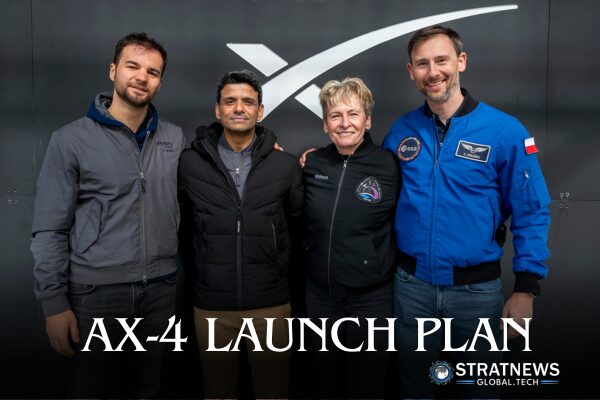The countdown has begun, and with it, India’s space dreams are set to soar once again. On June 10, 2025, at 5:52 pm Wednesday, Indian Standard Time (IST), Group Captain Shubhanshu Shukla will become the second Indian in history to travel to space, breaking a four-decade hiatus since Wing Commander Rakesh Sharma’s legendary mission in 1984.
This time, however, India’s role is not of a guest in a foreign program. With Gp Capt Shubhanshu Shukla on board Axiom Mission 4 (Ax-4), the country steps forward as an active participant in the new space age, one driven by global collaboration and commercial innovation.
“India Didn’t Stop Dreaming” – The Long Wait Ends
For many Indians, this mission is not merely a scientific endeavour — it is a deeply personal, emotional return. “During these 40 years, India did not stop dreaming,” highlights Dr Srimathy Kesan, founder and CEO of Space Kidz India, in conversation with StratNewsGlobal. “Instead, it built a space program admired worldwide — from launching hundreds of satellites to touching the Moon and Mars.”
Kesan reflects on the symbolic weight of this moment: “Now, with Subhansu and his team set to fly, India once again becomes a direct participant in human space exploration. This moment is not just about national pride — it’s about reclaiming a dream that was put on pause.”
From ‘Saare Jahan Se Achha’ to Global Collaboration
In 1984, Rakesh Sharma’s poetic words from space — “Saare Jahan Se Achha” — stirred a sense of collective pride. His journey aboard the Soviet Soyuz T-11 placed India on the global space map. But the opportunity was singular, shaped by Cold War geopolitics.
“Back then, we relied on foreign partnerships,” she explains. “Today, we are equal collaborators. That’s the real transformation.”
Now, as part of the Ax-4 crew alongside American commander Peggy Whitson, Polish astronaut Sławosz Uznański-Wiśniewski, and Hungarian researcher Tibor Kapu, Gp Capt Shubhanshu Shukla will represent India in a commercial, globally collaborative mission — highlighting how far the nation has come.
Science, Symbolism, and Training for Tomorrow
The mission, led by Axiom Space in coordination with NASA, ISRO, and ESA, is designed to showcase the future of international spaceflight. The SpaceX Crew Dragon spacecraft, launched atop a Falcon 9 rocket, will ferry the crew to the International Space Station (ISS) for a 14-day stay.
For Kesan, the mission’s scope is as important as its symbolism. “This isn’t just about reaching space. It’s about participating in research that could benefit life both in orbit and back on Earth,” she says. The Ax-4 team will conduct 60 experiments, including 12 from India focused on space agriculture, microbial adaptation, and human-technology interaction in space.
Among the most intriguing are studies on tardigrades — microscopic organisms capable of surviving extreme conditions. “These tiny creatures could unlock insights into stress and radiation tolerance,” she notes. “Imagine what that could mean for future deep space missions — or even healthcare here on Earth.”
An Inspiration to the Next Generation
Dr. Kesan, whose organization has engaged thousands of Indian students in space science, sees Gp Capt Shukla’s mission as a rallying cry for youth. “It tells every student, every dreamer: You too can go to space. It’s not a fantasy anymore — it’s a future we are actively building.”
She highlights the importance of representation. “When children see someone like Shubhanshu Shukla in space, they begin to believe it’s possible for them. That’s the power of this mission — it turns aspiration into ambition.”
India’s Strategic Stakes
While Ax-4 is a commercial mission, its value to India’s national space ambitions is immense. Gp Capt Shubhanshu Shukla is one of four astronauts selected for ISRO’s Gaganyaan human spaceflight program, scheduled for 2027. His experience aboard Ax-4 will offer crucial technical, operational, and psychological data needed for India’s first fully indigenous crewed mission.
“Subhansu’s role in Ax-4 is a precursor to Gaganyaan,” Kesan asserts. “The skills he will apply — especially docking, microgravity handling, and international coordination — will feed directly into ISRO’s mission planning.”
Notably, recent ISRO experiments like POEM-4, where cowpea seeds sprouted in orbit, and SpaDeX, which tested space docking technologies, are being seen as critical data points supporting both Ax-4 and Gaganyaan.
Reflecting on astronaut selection, Dr. Kesan explains that modern spaceflight demands far more than elite piloting skills. “Yes, Subhansu is a top-notch Indian Air Force officer — but that’s just the beginning. Astronauts today must excel in STEM, physical endurance, mental resilience, and teamwork.”
She adds that modern missions even open doors to scientists, educators, and researchers from non-traditional backgrounds — provided they meet the rigorous training benchmarks.
The Launch Ahead: India Looks Skyward
The Ax-4 mission is set for liftoff from Launch Complex 39A at NASA’s Kennedy Space Center in Florida. Once docked with the ISS, the crew will embark on experiments impacting biology, earth observation, and space engineering — representing over 30 countries.
After the mission, the SpaceX Dragon will re-enter Earth’s atmosphere and splash down in the ocean, bringing the astronauts — and invaluable science — back to Earth.
And while the launch vehicle may be American, the sense of pride coursing through India is unmistakably homegrown.
“This is not just a return to space,” says Dr. Kesan. “It’s a statement that India belongs in the global human spaceflight community — not someday, but now.”
A New Dawn for India’s Space Aspirations
As the final countdown draws near, the nation watches with anticipation. From a lone Soyuz seat in 1984 to a collaborative launch in 2025, and toward a self-reliant mission in 2027 — India’s journey to the stars is gathering momentum.
With Gp Capt Subhansu Shukla’s flight, a 40-year silence is about to be broken, not with nostalgia, but with a forward-looking vision — bold, scientific, and deeply Indian.


